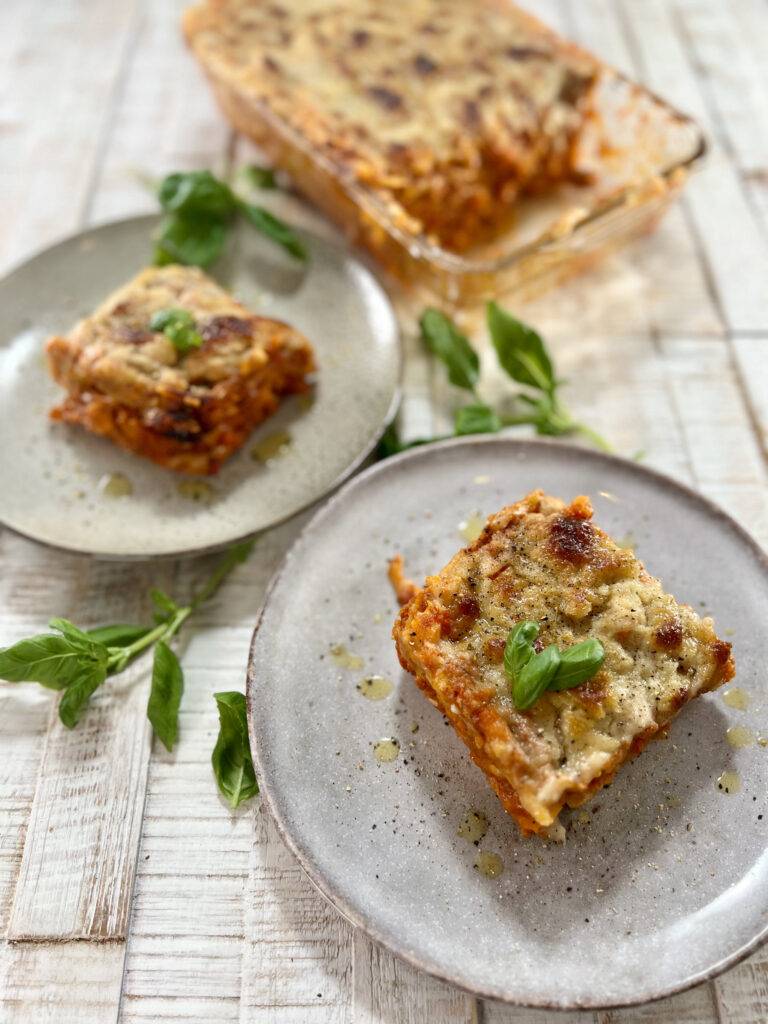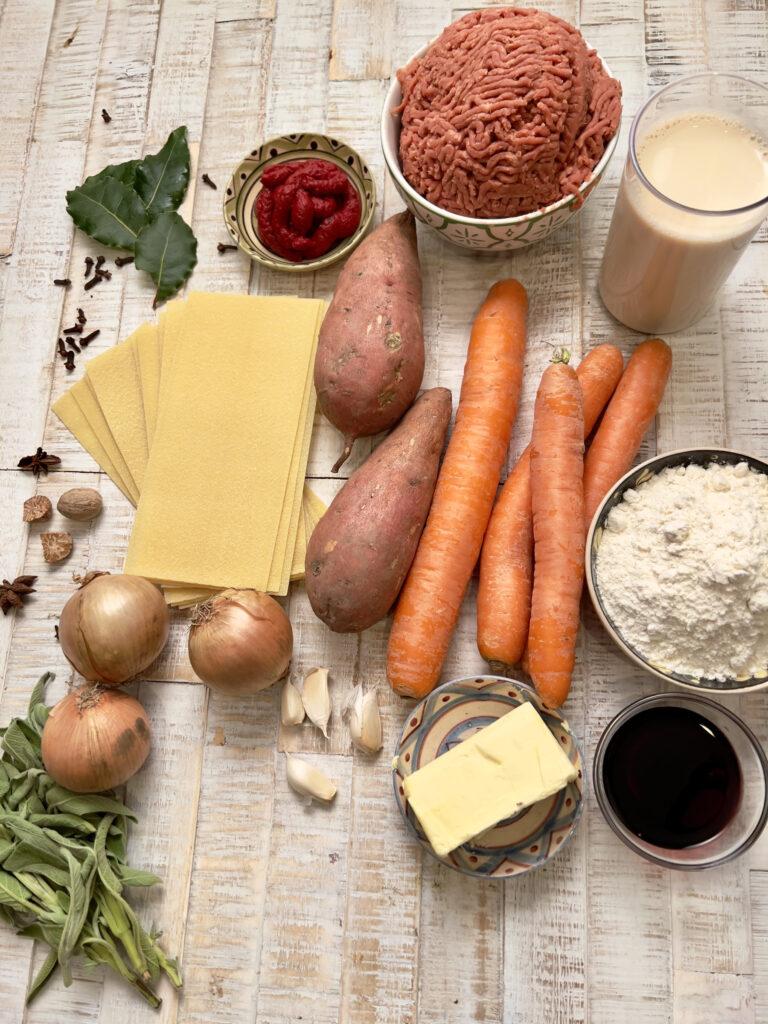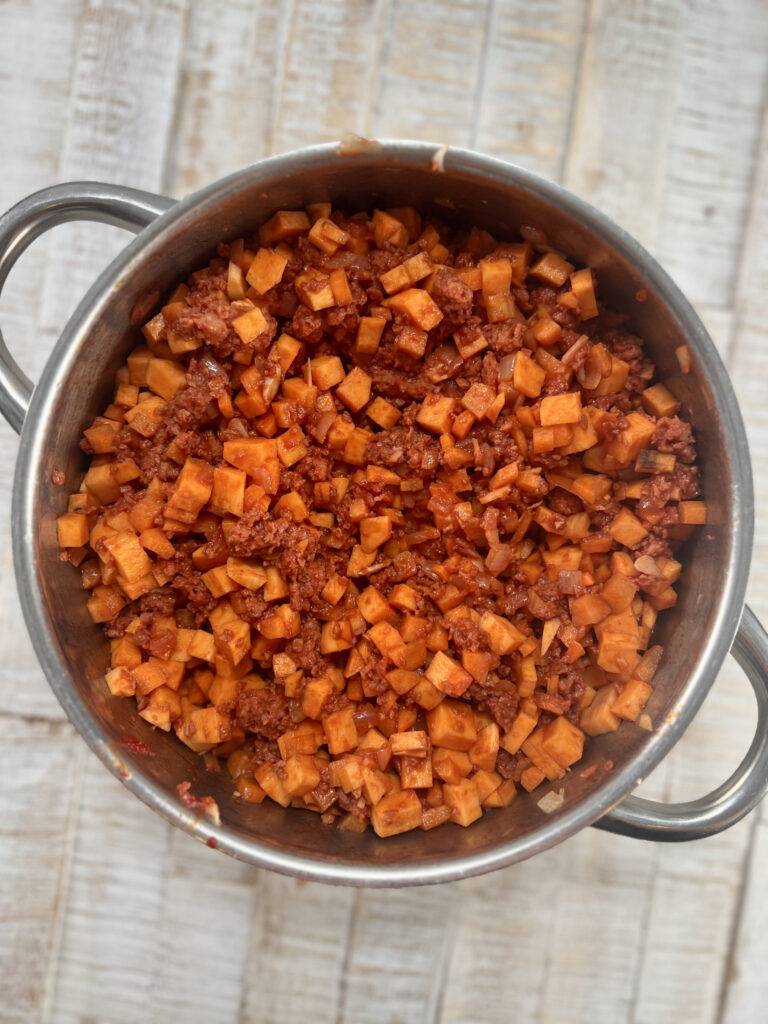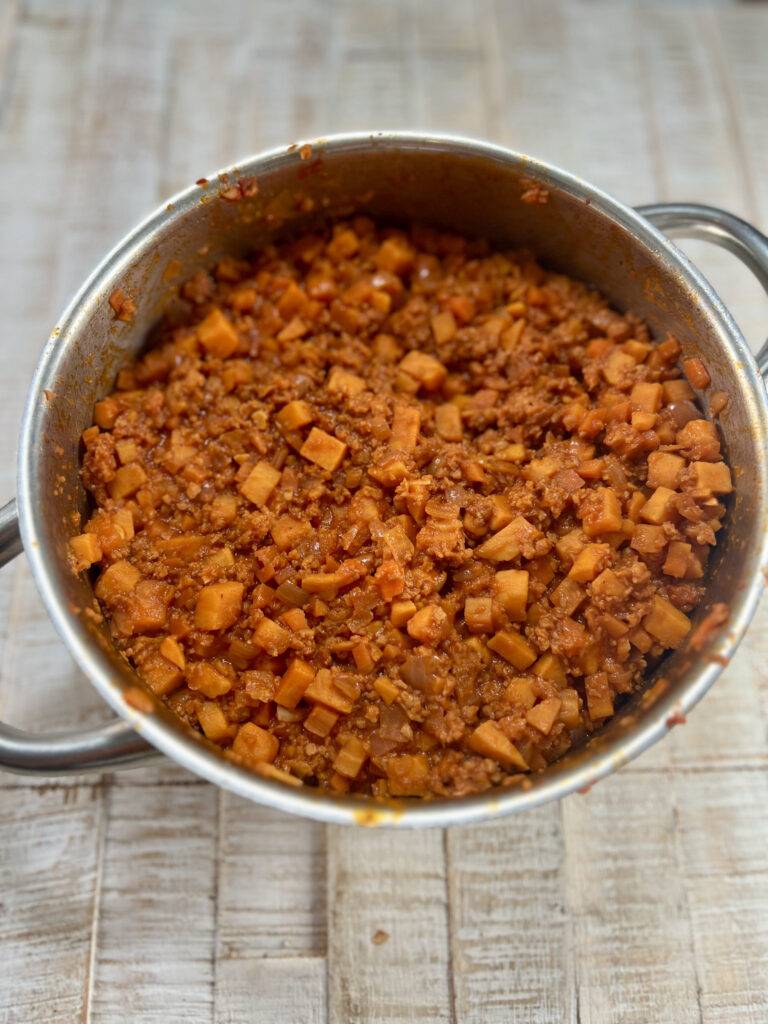
I have a recipe that I am particularly proud of: A vegan sweet potato lasagna. I’ve always loved cooking lasagna. Over the years, this one has developed from trial and error. It is the perfect hearty dish and literally cosiness on a plate. Next to being incredibly tasty, this lasagna is fun to cook and packed with healthy fibres and protein. So, let’s make ourselves a fine dinner!
For the people who are sceptical about vegan lasagna, I dare them to try this recipe. It is one of my favourites, and I haven’t met a single person who didn’t like this lasagna. The greatest honour of all: It has withstood the test of critical grandparents! I love this vegan lasagna recipe so much that I used to make a big tray of lasagna every other week and eat it for days from it, but most times, it lasted wayyy shorter than what I budgeted for.

If you have a bit more discipline than I do, this lasagna works well for meal prep. It will give you instant satisfaction after coming home from sports or as a satisfying dinner after a long day of work or
studying. Reheat it for a few minutes, and get ready to indulge!
Even though this recipe seems like quite an effort at first, I can assure you that you will understand to cook it quickly after some experimenting. It is definitely worth the hassle to own this recipe!
Let’s get started. We will draw some inspiration from traditional Lasagna al Forno, but we will change things up a lot, so this dish is by no means a traditional lasagna. Especially during the autumn and winter season, it tastes fantastic to add some autumny flavours into the vegan ragù and bechamel sauce. And of course, our lasagna will be entirely plant-based!
Ingredients for the vegan lasagna:

To make the lasagna, we need to cook two separate parts, which we then combine into a beautiful dish: First, a ragù, the flavourful, meaty filling of the lasagna. Secondly, we will make a vegan bechamel sauce, giving the lasagna its delicious creaminess! Let’s have our ingredients sorted, so we can get cooking!
Ingredients for the ragù:
- Vegan ground meat substitute
- Sweet potatoes
- White onions
- Carrots
- Garlic
- Tomato concentrate
- Red Wine
- Olive oil
Ingredients for the vegan bechamel sauce:
- Oat milk
- Onion
- Garlic
- Vegan butter substitute
- Flour
Of course, you will also need Lasagna sheets!
Spices:
- Nutmeg
- Nutritional yeast
- Laurel leaves
- Herbs (Sage & basil)
- Salt & pepper
- Optional: cloves & Star anis
I am using a pea-protein-based meat substitute today. I have cooked the lasagna often using beyond-meat mince, which tastes fantastic too. If you are not a fan of these processed meat substitutes, you can experiment with lentils or minced button mushrooms instead.
When making lasagna during autumn or winter, I love adding some spices to the bechamel sauce. Their flavour makes the dish extra comforting! I’d always recommend adding laurel and nutmeg to this lasagna, but the other ones are optional.
Finally, you may want to have some extra vegan parmesan substitute on hand for plating the lasagna.
Cooking the vegan lasagna:
Preparing the ingredients for the ragù
Let’s start by preparing the ragù. First, peel two onions and dice them into small cubes. Take your garlic cloves and mince them finely. Peel your carrots and dice them into small cubes. Peel your sweet potato, and chop it into slightly bigger cubes. Also, wash the sage, pat the leaves dry, and mince a heaped tablespoon worth of them.

Preparing ingredients for the bechamel sauce:
For the bechamel sauce, take your plant-based milk out of the fridge and let it heat to room temperature. The room-temperature liquid will make the process of making the bechamel sauce easier. Also, I crush and peel another garlic clove. Peel your last onion and slice it in half.
Cooking a vegan ragù:
Heat a dash of olive oil in a deep pot. Add the onions and sage, and sauté until softening and turning translucent. Next, add the garlic and tomato puree. You want some roast aromas to develop during this step, but be careful not to burn anything. Add the meat substitute, mix well and sauté for a few more minutes before deglazing the pot with red wine. Now, you can add the carrots and sweet potato. Simmer the ragù with a lid closed, but stir frequently, so nothing burns at the bottom.
Altogether, you want the ragù to remain pretty dry. The vegetables bring some moisture, and too much liquid will harm the final consistency of the lasagna. You can add a sip of water, red wine, or vegetable stock if needed. Let the ragù to simmer until the vegetables turn soft. That process can well take another 20 minutes of cooking.

Making a great plant-based Bechamel sauce:
Take your plant-based butter substitute, and let it melt in a pot. You want to keep the heat low-medium for this step. When the butter has melted and heated nicely, add the flour, and mix it in. It should create a doughy, crumbly mix. I like to toast the flour for a minute, which develops a slightly deeper flavour.

Reduce the heat to low. Now it’s time to be careful and patient. Start by adding small sips of oat milk to the flour mix, and whisk it thoroughly. Adding too much liquid will lead to a lumpy sauce, which we want to avoid at all costs. Once the sauce thins, you can add larger quantities of the milk substitute. Repeat this until you have incorporated all the plant-based milk into the mix. Add your spices and a generous dusting of nutmeg. I like to stick the cloves into the onion and add it to infuse its flavour into the sauce. That trick makes it easier not to lose the cloves in the sauce.

Now, patiently stir the sauce so no lumps can form, and let it thicken. I like a thick bechamel sauce for this recipe. You want a consistency where you can still spread the sauce without a problem but with as much consistency as possible. Season the sauce with salt and pepper.

Finishing the ragù
By now, the ragù should have reached a thick consistency! To round it off, check for seasoning, and dare to add a bit of nutmeg to the ragù as well.

Assembling the vegan lasagna:
Now, the fun part begins: Everything comes together: Assembling the lasagna. Take your baking dish, and give it a light brush with a small sip of oil. This will help the edges to crisp up nicely and prevent the lasagna from sticking. Now, start with a small layer of the ragù as the first layer, and then continue assembling the lasagna by repeatedly adding bechamel sauce, lasagna sheets and ragù.
I’d recommend opting for thin layers (this is why to avoid larger chunks of vegetables in the ragù) and trying to get as many layers in as possible. Having 4 – 5 layers will give your lasagna an amazing structure, and make sure it says nicely in shape when plating. Lastly, you want to have a bit of bechamel sauce left, which you can use to make a cheesy topping for your lasagna.

Making a vegan cheesy topping:
Put your remaining bechamel sauce back on the heat and gently warm it. You can melt in a vegan cheese substitute, but I like using nutritional yeast. The sauce has a creamy consistency, and introducing a cheesy flavour with nutritional yeast does the trick. Add the top layer, and finish the dish by sprinkling nutritional yeast and a pinch of nutmeg before putting your beauty into the oven!

I baked mine for 30 minutes at 170° Celsius (338° Fahrenheit) and used the broiler function at 190° Celsius (374° Fahrenheit) for the last five.

While the lasagna is baking, you can prepare your garnishes. You pick some fresh basil leaves, which I’ll do today. Otherwise, especially when going for an autumny lasagna, you can fry some remaining sage leaves in olive oil, similar to what I did for the pumpkin soup. The crispy leaves and the infused olive oil make a delicious topping for the lasagna.
Plating the vegan lasagna:
You can now plate your lasagna. I find that the consistency even gets better when allowing the lasagna to rest for 15 minutes before slicing and plating, but I won’t blame you if you get impatient when having this beautiful dish in front of you.
You can garnish the plated lasagna with fried sage leaves or basil, a dash of (infused) olive oil, a few cracks of black pepper and sea salt, or some vegan parmesan substitute.
I hope you enjoyed this vegan lasagna recipe! Let me know in the comments what you think. Enjoy!
Looking for some nice starter dishes to make this a full-course dinner?
- This fresh tomato apple bruschetta can’t go wrong!
- A light roasted tomato soup makes a great starter!
- Garlic Rosemary Beans on a crostini never disappoint either.
Some other recipes you might love:
- A delicious vegan chilli! It’s easy to make, and loaded with protein!
- This vegan moussaka is the greek best friend of this lasagna!
- This leek bake is as simple as it is delicious.
- Vegan potatoes au gratin are a treat.
- Try this delicious vegan shepherd’s pie.
- Check out this vegan quiche recipe for a delightful dinner.
Best Vegan lasagna Recipe
Course: Main, DinnerCuisine: VeganDifficulty: Medium6
servings30
minutes1
hour20
minutesThis delicious vegan lasagna is meaty, and has a deliciously sweet, autumny flavour. One of my favourite dishes!
Ingredients
500g minced meat substitute
2 small sweet potatoes
200g tomato concentrate
3 carrots
80ml red wine
1l oat milk
3 tbsp nutritional yeast
130g vegan butter
130g all-purpose flour
1 tbsp nutmeg
80ml olive oil
3 small white onions
4 cloves garlic
1 pack lasagna sheets
3 laurel leaves
A few leaves of basil
1 handful of sage leaves
Salt & pepper to season
Optional: Vegan cheese or vegan parmesan substitute
Optional: 2 star anis & 6 cloves
Directions
- Take your garlic cloves and mince them finely. Finely dice two of the onions. Peel your carrots and sweet potato, and dice them into small cubes. Also, wash the sage, pat the leaves dry, and mince a heaped tablespoon worth of them.
- Let the oat milk heat to room temperature. Crush and peel another garlic, peel the remaining onion and cut it in half.
- Heat a dash of olive oil in a deep pot. Add the onions and sage, and sauté until softening and turning translucent. Next, add the garlic and tomato puree. You want some roast aromas to develop during this step, but be careful not to burn anything. Add the meat substitute, mix well and saute for a few more minutes before deglazing the pot with red wine.
- Add the carrots and sweet potato. You might want to add a bit of additional liquid if needed, you can use red wine, vegetable stock or water.
- Simmer the ragu with a closed lid, until the vegetables turn soft and everything comes together nicely. That process can well take another 20 minutes of cooking.
- Take your plant-based butter substitute, and melt it in a pot. You want to keep the heat low-medium for this step. When the butter has melted, add the flour, and mix it in. It should create a crumbly batter. Toss and toast for a minute before reducing the heat to low.
- Start adding small sips of oat milk to the batter and whisking it thoroughly. Adding too much liquid will lead to a lumpy sauce, which we want to avoid at all costs. Repeat this until you have incorporated all the plant-based milk into the mix.
- Add your laurel, star anis, halved onion, crushed garlic clove, and a generous dusting of nutmeg. I like to stick the cloves into the onion and add it to infuse its flavour into the sauce.
- Patiently stir the sauce so no lumps can form, and let it thicken. Season the sauce with salt and pepper, and let it finish simmering while finishing the preparation of the ragù.
- Add a bit of nutmeg to the ragù as well. Furthermore, season to taste with salt and pepper, and take from the heat.
- Take your baking dish, and start by putting a small layer of the ragù as the first layer. Then, continue assembling the lasagna by repeatedly adding bechamel sauce, lasagna sheets and ragù. You should aim for around four layers of each ingredient.
- Add nutritional yeast to the remaining bechamel sauce to make a cheesy topping layer. You can use melting vegan cheese substitutes.
- Add the top layer, and finish the dish with a pinch of nutmeg before putting your beauty into the oven. Bake it for 30 minutes at 170° Celsius (338° Fahrenheit) and use the broiler function at 190° Celsius (374° Fahrenheit) for the last five.
- As toppings, you can take some fresh basil leaves or fry the remaining sage leaves in olive oil.
- Let the lasagna rest for 15 minutes before slicing and plating. Optionally, plate the lasagna with a crack of salt & pepper, basil or fried sage leaves, olive oil, or a vegan parmesan substitute.

